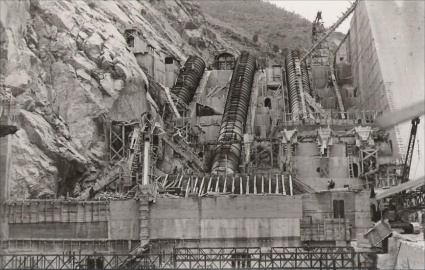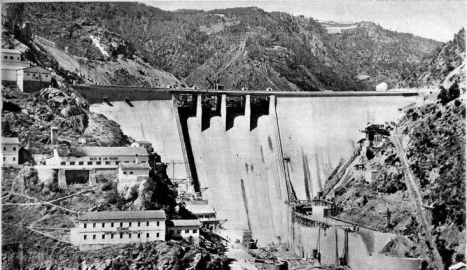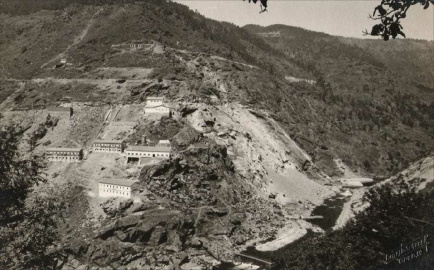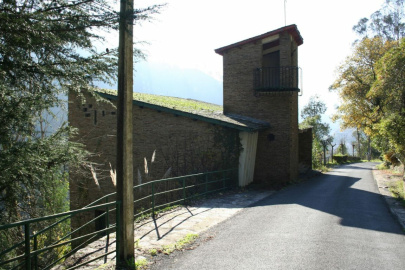
16.8 Presa de Peares
THE DAM AT OS PEARES
This dam was the first of several major public works projects along the Miño River for producing hydroelectric power, which would come to include the dams built at Os Peares (1955), Belesar (1963), Velle (1966), Castrelo de Miño (1968), and Frieira (1969).
To better understand the need for this infrastructure, we have to travel back to Spain in the period after its Civil War (1936-1939). No investment was flowing into the country and it was hard to import materials, which was seriously hindering electricity production. In fact, during the 1940s, and up until 1955, power outages were a frequent occurrence in Spanish homes.
To address this scenario, Franco’s government decided to create a widespread network of new reservoirs, to ensure sufficient electrical supply, advance the country’s industrial development, and avoid dependence on foreign energy sources.
Construction of the dam at Os Peares began in 1945, and in 1952, filling of its reservoir began. Although electricity production first became possible in 1953, the dam itself was not fully completed and inaugurated until 1955. At that time, the hydroelectric power plant was far and away the largest in Galicia, producing a power level of 151 MW (now increased to 159.1 MW), 6 times more than the amount produced by the dam at As Conchas.
Thanks to this increase in the electricity produced, along with the projects taking place at the other dams, electrical lines could be used to transmit this electricity to other locations, first within the northern part of Galicia and later into the rest of Spain.
This dam consists of a wall that is 94 metres high, which has created a reservoir with a volume of 182 hm3. The reservoir extends for about 24 kilometres until reaching the town of Belesar, where not far upstream there is another dam. This Belesar dam was completed in 1963, and by any measure it greatly surpassed the dam at Os Peares: 132 metres in height, with a reservoir capacity of 655 hm3, a reservoir length of 50 kilometres, and a power production level of 227 MW (now increased to 330 MW).
WORKERS’ VILLAGE
Because so many workers were needed in order to build and operate the dam, some had to be brought in from other locations. As housing for those workers, a series of 12 buildings were constructed on an adjacent slope, just below the wall of the dam.
This workers’ village was designed by the architect Antonio Tenreiro Brochón as a series of two‑story buildings, with their walls coated in plaster and sprayed cement. They featured bases made of stone or slate (like their chimneys), slate roofing tiles, and chestnut wood carpentry.
The workers living here had access to all necessary services, including a school and a chapel. After remodelling of an old administrative building, this village became one of the examples of Modernist architecture in Galicia recognised by Docomomo International, an organization focused on preserving buildings from that era.
When this workers’ village was no longer needed it became abandoned for decades. Fortunately, the village was renovated in the early 21st century, and it has now become a Linguistic Immersion Centre, where students are able to take up residence while studying English.
 Directions
Directions 


